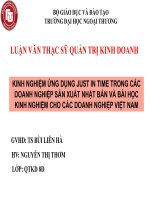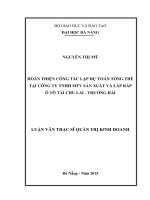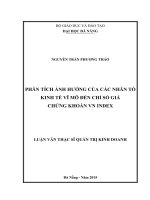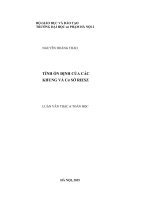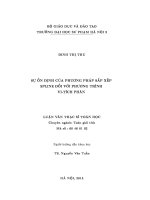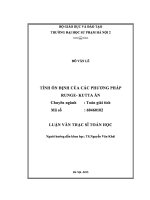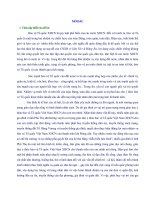(Luận văn thạc sĩ) study on potential filter materials for use as substrate in constructed wetlands to strengthen phosphorus treatment performance from swine wastewater001
Bạn đang xem bản rút gọn của tài liệu. Xem và tải ngay bản đầy đủ của tài liệu tại đây (3.41 MB, 119 trang )
VIETNAM NATIONAL UNIVERSITY, HANOI
VIETNAM JAPAN UNIVERSITY
NGUYEN THI THUONG
STUDY ON POTENTIAL FILTER
MATERIALS FOR USE AS SUBSTRATE
IN CONSTRUCTED WETLAND
TO STRENGTHEN PHOSPHORUS
TREATMENT PERFORMANCE
FROM SWINE WASTEWATER
MASTER'S THESIS
Hanoi, 2019
VIETNAM NATIONAL UNIVERSITY, HANOI
VIETNAM JAPAN UNIVERSITY
NGUYEN THI THUONG
STUDY ON POTENTIAL FILTER
MATERIALS FOR USE AS SUBSTRATE
IN CONSTRUCTED WETLAND
TO STRENGTHEN PHOSPHORUS
TREATMENT PERFORMANCE
FROM SWINE WASTEWATER
MAJOR: ENVIRONMENTAL ENGINEERING
CODE: PILOT
SUPERVISORS
DR. NGUYEN THI AN HANG
ASSOC. PROF. DR. SATO KEISUKE
DR. VU NGOC DUY
Hanoi, 2019
ACKNOWLEDGMENTS
First of all, I would like to express my heartfelt gratitude to my principal
supervisor, Dr. Nguyen Thi An Hang for giving me a chance to explore an exciting
research field – the constructed wetlands, for always inspiring me. She has spent
plenty of time for teaching, explaining hard questions as well as sharing her own
experiences in approaching and solving research problems. Thanks to that, I was
well equipped with essential knowledge and skills to fulfill my research. I also
express my deepest thanks to Assoc. Prof. Dr. Sato Keisuke, who provided me a
great guidance during my internship. Besides teaching, providing knowledge and
enthusiastic support, he always treated me tenderly likes my father. In addition, he
helped me not to be confused when I first arrived in Japan. My special thanks go to
Dr. Vu Ngoc Duy, who gave me valuable supports in developing research methods,
implementing experiments, and deepening my research.
The second, I want to send my sincere thanks to VNU Vietnam Japan
University (VJU), Ritsumeikan University (RITs), Shimadzu Corporation and
Shigaraki Center for warm welcome and enthusiastic support during my internship
in Japan. Without their precious supports, I would not be able to complete this
research. Especially, I would like to convey my devoted appreciation to Prof. Dr.
Jun Nakajima, Assoc. Prof. Dr. Hiroyuki Katayama, for teaching and supporting me
during my study at VJU.
This research is funded by Vietnam National Foundation for Science and
Technology Development (NAFOSTED) under grant number 105.99-2018.13,
2018, Asean Research Center (ARC) research grant of Vietnam National
University, Hanoi (VNU), and Japan International Cooperation Agency (JICA).
Last but not least, my profound gratitude goes to my family for their spiritual
supports during my thesis writing and my daily life as well. This accomplishment
would not have been possible without them.
Hanoi, May 31th, 2019
Nguyen Thi Thuong
i
TABLE OF CONTENTS
ACKNOWLEDGMENTS........................................................................................... i
TABLE OF CONTENTS ........................................................................................... ii
LIST OF TABLES .................................................................................................... iv
LIST OF FIGURES................................................................................................... iv
LIST OF ABBREVIATIONS .....................................................................................v
INTRODUCTION................................................................................................................ 1
CHAPTER 1. LITERATURE REVIEW ........................................................................... 7
1.1 Phosphorus (P) pollution and its consequences ........................................................... 7
1.2 Regulations related to P removal................................................................................... 8
1.3 Phosphorus treatment technologies .............................................................................11
1.4 Constructed wetlands (CWs) system for wastewater decontamination....................19
1.4.1 Definition ...................................................................................................................19
1.4.2 Classification .............................................................................................................19
1.4.3 Application of CWs in wastewater treatment.........................................................23
1.4.4 Factors influencing the CWs treatment performance ............................................25
1.4.5 Mechanisms of P removal in CWs...........................................................................29
1.5 Removing P by substrates in CWs ..............................................................................31
1.6 Overview of research objects .....................................................................................33
1.6.1 Swine waste water .....................................................................................................33
1.6.2 Ca-rich bivalve shell as the substrate in CWs .........................................................35
CHAPTER 2. MATERIALS AND RESEARCH METHODOLOGY..........................41
2.1 Materials and equipment..............................................................................................41
2.2 Experiment setting up ..................................................................................................45
2.2.1 Modification of materials .........................................................................................45
2.2.2 Characterization of the developed material .............................................................46
2.2.3 Adsorption experiments ............................................................................................49
2.2.4 Removal of P from synthetic wastewater using the integrated CWs- adsorption
system ................................................................................................................................51
ii
2.3 Analytical methods.......................................................................................................53
2.3.1. Phosphorus analysis .................................................................................................53
2.3.2. Other parameters analysis ........................................................................................53
2.4. Data statistical analysis ...............................................................................................53
CHAPTER 3. RESULTS AND DISCUSSION ........................................................55
3.1 Screening of filter materials for use as substrate in CWs ..........................................55
3.1.1 Comparing potential materials based on P adsorption capacities ..........................55
3.1.2 Comparing filter materials based on their permeability .........................................57
3.1.3 Comparing filter materials based on their side effects............................................58
3.1.4 Selection of potential filter materials .......................................................................62
3.2 Intensive investigation of the selected filter materials –white hard clam (WHC) ...64
3.2.1 Identification of the optimal modification conditions of WHC ............................64
3.2.2 Physicochemical properties.. ....................................................................................66
3.2.3 Batch experiment ......................................................................................................70
3.2.4 Column experiment ...................................................................................................80
3.2.5 Comparing the P removal efficiency of modified white hard clam (WHC-M800)
in the synthetic and real swine wastewater .......................................................................82
3.3. The P treatment performance in the integrated CWs – adsorption system ............83
CHAPER 4. CONCLUSION AND RECOMMENDATION .......................................88
4.1 CONCLUSION ............................................................................................................88
4.2 RECOMMENDATION ..............................................................................................89
REFERENCES ...................................................................................................................90
APPENDICES ..................................................................................................................108
Appendix 1: Visiting some CW systems during internship in Japan ............................108
Appendix 2: Preparing WHC as the substrate in CWs ..................................................109
Appendix 3: Designing and operating the integrated CW-adsorption system .............110
iii
LIST OF TABLES
Table 1.1 Effluent discharge standards of different countries ........................................... 8
Table 1.2 Phosphorus removal efficiencies of different methods ...................................17
Table 1.3 Mechanism of phosphorus removal in constructed wetland system ..............30
Table 1.4 Some filter media used for P removal ..............................................................32
Table 1.5 The main composition of swine wastewater after anaerobic digestion by
biogas chamber...................................................................................................34
Table 1.6 The main chemical compositions of bivalve shells and limestone................37
Table 1.7 Some studies used bivalve shell for P removal................................................39
Table 3.1 Phosphorus adsorption capacity of different materials ..................................57
Table 3.2 Permeability constant (K) of investigated materials........................................58
Table 3.3 The concentration of heavy metals released from materials ...........................61
Table 3.4 Summary of the obtained scores for investigated materials .................. Error!
Bookmark not defined.
Table 3.5 Effect of calcination temperature .....................................................................65
Table 3.6 Effect of the calcination time ...........................................................................66
Table 3.7 Brunauer Emmett Teller (BET) analysis..........................................................67
Table 3.8 Elemental content of WHC ...............................................................................68
Table 3.9 Elemental content of WHC-M800 ...................................................................68
Table 3.10 Langmuir and Freundlich adsorption isotherm constants .............................78
Table 3.10 P adsorption capacity at different conditions .................................................81
Table 3.11 Parameters of real post-biogas swine wastewater in Chuong My, Hanoi..83
Table 3.12 The phosphorus concentrations before and after treatment with horizontal
flow lab-scale constructed wetlands .................................................................85
Table 3.13 The phosphorus removal efficiency and pH after treatment with horizontal
flow lab-scale constructed wetlands .................................................................86
iv
LIST OF FIGURES
Figure 1: Thesis‘s outline ..................................................................................................... 6
Figure 1.1 Eutrophication from phosphorus contamination .............................................. 7
Figure 1.2 The treatment technologies for phosphorus removal .....................................11
Figure 1.3 Metabolic pathways of PAO under aerobic and anaerobic conditions. ........15
Figure 1.4 The classification of CWs used in wastewater treatments.............................19
Figure 1.5 The schematic surface flow constructed wetland. ..........................................20
Figure 1.6 The schematic vertical flow constructed wetland .........................................21
Figure 1.7 The schematic horizontal flow constructed wetland. .....................................21
Figure 1.8 The schematic hybrid constructed wetland.....................................................22
Figure 1.9 Phosphorus cycle in constructed wetland .....................................................29
Figure 1.10 The main clam species in Vietnam ...............................................................37
Figure 2.1 Images of investigated filter materials ............................................................41
Figure 2.2. The routine to Thai Binh shellfish Co., Ltd, Tien Hai Thai Binh ................42
Figure 2.3 Procedure to prepare WHC as phosphorous adsorbent .................................43
Figure 2.4 The pig farm in Chuong My, Hanoi...............................................................44
Figure 2.5 Equipments used in this study .........................................................................45
Figure 2.7 The experiment setting according to Darcy law .............................................47
Figure 2.8 Procedure for determine of porosity ...............................................................47
Figure 2.9 Small column adsorption test ..........................................................................51
Figure 2.10 Integrated CWs-adsorption systems..............................................................52
Figure 2.11 Calibration curve for phosphorus analysis ...................................................53
Figure 3.1 Comparison of P adsorption capacity of investigated filter materials ..........56
Figure 3.2 pH of post-adsorption solutions......................................................................59
Figure 3.3 Images of raw WHC and WHC modified at different temperatures ............65
Figure 3.4 SEM observation for WHC .............................................................................67
Figure 3.5 SEM observation for ........................................................................................67
Figure 3.6 EDX spectrum of WHC ...................................................................................68
Figure 3.7 EDX spectrum of WHC-M800 .......................................................................68
v
Figure 3.8 FTIR analysis for WHC ...................................................................................69
Figure 3.9 FTIR analysis for WHC WHC-M800.............................................................69
Figure 3.10 Effect of pH of WHC on phosphorus removal ............................................71
Figure 3.11 Effect of pH of WHC-M800 on phosphorus removal .................................71
Figure 3.12 Effect of dosage of WHC on phosphorus removal ......................................73
Figure 3.13 Effect of dosage of WHC-M800 on phosphorus removal..........................73
Figure 3.14 Effect of temperature of WHC on phosphorus removal .............................74
Figure 3.15 Effect of temperature WHC-M800 on phosphorus removal ......................74
Figure 3.16 The fitting of isotherm models to P adsorption onto WHC.........................77
Figure 3.17 The fitting of isotherm models to P adsorption onto WHC-M800 .............77
Figure 3.18 Linear form of adsorption isotherm following Langmuir of WHC ............77
Figure 3.19 Linear form of adsorption isotherm following Freundlich of WHC ..........77
Figure 3.20 Linear form of adsorption isotherm following Langmuir of WHC-M800.78
Figure 3.21 Linear form of adsorption isotherm following Freundlich of WHC-M800
.............................................................................................................................78
Figure 3.22 Kinetic test of WHC ......................................................................................79
Figure 3.23 Kinetic test of WHC-M800 ...........................................................................79
Figure 3.24 Breakthrough curve of WHC-M800 for P removal under the different
flowrate ...............................................................................................................81
Figure 3.25 Breakthrough curve of WHC-M800 for P removal under the different
initial concentration............................................................................................81
Figure 3.26 Breakthrough curve of WHC-M800 for P removal under the different
weight of material .............................................................................................81
Figure 3.28 P adsorption capacity of WHC-M by real wastewater and synthetic
wastewater ..........................................................................................................83
Figure 3.29 The change of phosphorus in the effluent over the time..............................85
vi
LIST OF ABBREVIATIONS
BET
Brunauer emmett teller
BOD
Biological oxygen demand
COD
Chemical oxygen demand
EBPR
Enhanced biological phosphorus removal
EPA
Environmental Protection Agency
FTIR
Fourier transform infrared spectroscopy
HAP
Hydroxyapatite
HLR
Hydraulic loading rate
HRT
Hydraulic retention time
MAP
Magnesium ammonium phosphate hexahydrate
MBRs
Membrane bioreactor
PAOs
Polyphosphate accumulating organisms
RO
SEM
USEPA
WHC
WWTP
Reverse osmosis
Scanning electron microscopy
United States environmental protection agency
White hard clam
Wastewater treatment plant
vii
INTRODUCTION
Background
Swine breeding industry is an important part of agriculture sector in Vietnam. In
recent years, numerous large scales of pig farms have been developed to meet the
pork demand in the market. According to General Statistics Office of Vietnam
(2018), the whole country has about 500,000 livestock households, over 29 million
pig heads, 3.8 million tons of meat. Also, as the pig producer, Vietnam is the biggest
in ASEAN and the seventh biggest in the world. The swine breeding industry has
promoted the economic development as well as the GDP of the country.
Despite the huge economic benefits, pig breeding industry makes many
environmental problems, which negatively affect to human health and ecosystems.
That is because swine wastewater normally contains high concentration of nutrients,
such as phosphorus (P) and nitrogen (N) that are main reasons for eutrophication
(Wang et al., 2013).
Currently, the most common method for swine wastewater treatment is
anaerobic digestion using biogas chamber. However, according to several studies,
the concentration of pollutants in the effluent after biogas treatment is still very
high, exceeding the permitted discharge standards (National Institute of Animal
Husbandry, 2015). Thus, further treatment is necessary to ensure the concentration
of P in the effluent meets requirements (Ngo, 2013; Nguyen, 2016). Among several
technologies utilized for swine wastewater treatment, constructed wetland has
shown a promising technology.
Constructed wetlands (CWs) have been applied as a green technology to treat
various kinds of wastewater. This technology is gaining much attention of scientists
in all over the world, especially in developing countries (Wu et al., 2015). That is
because CWs have many advantages, such as low cost, simple operation, high
removal efficiency, high biodiversity value, and great potential for water and
nutrient reuse (Kadlec, 2009; Vymazal, 2007; Zhang, 2014).
1
In addition, Vietnam is a tropical country with the hot and humid climate,
which is appropriate for the growth of plants and microorganisms in CWs. Thus,
CW is a potential wastewater treatment method and can replace or support other
high-cost chemical and physiological technologies (Nguyen, 2015).
The main concern with the swine wastewater is high content of organic matter,
nitrogen and phosphorus. While CWs can remove organic matter, suspended solids
and nitrogen efficiently, its removal efficiency of phosphorus is still low, unless
special filter materials with high P sorption capacity are utilized (Almuktar et al.,
2018). Therefore, in order to strengthen P removal from wastewater using CWs, it is
necessary to identify the potential filter materials with high P binding capacity
(Vohla et al., 2011).
Previously, there have been many studies on P removal by CWs, which
utilized a wide range of filter materials, including natural materials (rock, gravel,
mineral materials, apatite, etc.), industrial by-products (steel, ash, iron ore, etc.) and
artificial products (Johansson, 2006). Research results showed that when absorptive
materials were used as substrates, the P removal efficiency of CWs was
significantly improved in comparison with those using conventional filter materials,
such as sand and gravel (Johansson Westholm, 2006). Therefore, the finding of
filter materials, which are capable in P decontamination as CWs substrates,
continues to be of the great concern (Vohla et al., 2011). In Vietnam, the CW model
is still quite novel and not widely applied. So far, CWs have been applied for the
purification of several types of wastewater, such as sewage conveying river water
(Nguyen, 2011), domestics wastewater (Ngo & Han, 2012; Nguyen, 2015); landfill
leachate (Nguyen, 2012). However, to the best knowledge of the author, very few
studies on swine wastewater treatment using CWs can be found (Le, 2012; Ngo,
2013; Nguyen, 2016; Vu et al., 2014). Additionally, there is less of information
about the role of filter materials in the CWs. Meanwhile, Vietnam is known as a
country, which is rich in natural resource and, has large reserves of limestone and
laterite. Also, with long coast (3260 km), it has a great potential for clam and coral
2
production. As a result, a huge amount of solid waste can be generated, creating the
environmental burden. Besides, the large amount of agricultural and industrial byproducts (okara, coal slag, steel slag) discharged from the food processing and fuel
manufacturing… This is a great potential for the development of the constructed
wetlands based on the indigenous materials.
In brief, the use of special materials as filter media in CWs to intensify P
removal was reported somewhere. However, there are no studies in Vietnam using
locally available, adsorptive natural materials (laterite, limestone, coral), industrial
by-products (steel slag, coal slag, white hard clam) and agricultural by products
(okara) for enhancing phosphorus removal efficacy from swine wastewater.
In that context, this research “Study on potential filter materials for use as
substrate in constructed wetland to strengthen phosphorus removal from swine
wastewater” is necessary to strengthen P removal by CWs from swine wastewater
as well as to reduce solid waste.
3
Research objectives and scope
This study has three main objectives as follows:
(1) To determine potential filter materials for use as substrate in CWs for P removal
• To compare filter materials (based on adsorption capacity and other
selection criteria)
(2) To understand the physio-chemical and adsorptive characteristics of the selected
material
• To understand physicochemial properties of selected material;
• To clarify adsorption behaviors (adsorption capacity, adsorption
speed, adsorption efficiency in synthetic and real wastewater) of the
selected material;
• To evaluate the suitability of the selected material for use in CWs
(3) To evaluate the applicability of the selected material as the substrate in CWs for
P elimination
• To evaluate the P treatment performance in CWs
• To evaluate the contribution of different components (substrates,
plant) in CWs
• To evaluate the lifespan of the CWs
Research significance
The recycling of white hard clam shell (WHC) as a phosphorus adsorbent
results in double environmental benefits. It not only enhances the ability of CWs in
removing P from wastewater but also reduces the WHC shell as a solid waste in a
cheap and environmentally friendly way. Besides, it creates additional economic
value for WHC.
4
Thesis’ outline
The research’s outline is shown in the Figure 1. This thesis contains of 4
chapters. The main content of each chapter is presented as follows:
Introduction provides the research background, identifies research
objectives, research scope, main tasks, and research significance.
Chapter 1: Literature review provides information about phosphorus
pollution and consequences, the relevant regulations and treatment technologies.
The focus is placed on the role of substrate in CW for removing phosphorus from
swine wastewater.
Chapter 2: Research materials and methodology describes the materials,
equipment, and methods used in this study. Experiment setting-up is described in
detail. The analytical methods as well as instruments are also introduced.
Chapter 3: Result and discussion provides results on phosphorus
adsorption capacity, physicochemical properties of materials, isotherm, kinetics and
column studies, and P treatment performance in the CW-adsorption system.
Chapter 4: Conclusion and recommendation summaries the main
findings, limitations of this research and further research directions.
Appendices: includes some pictures of research activities of this study.
5
Introduction
Chapter 1: Literature Review
P pollution and its consequences
P removal technologies
P removal by substrate in CWs
Chapter 2: Materials and Methods
Materials and equipment
Experiment setting up
Analytical and data statistical methods
Chapter 3: Results and Discussion
Screening potential filter material
Intensive investigation of selected material
P treatment performance in CW system
Chapter 4: Conclusions and Recommendations
Figure 1: Thesis‘s outline
6
CHAPTER 1
LITERATURE REVIEW
1.1 Phosphorus (P) pollution and its consequences
Phosphorus is a crucial nutrient that extremely needed for the growth of plant
and animals (Han et al, 2015). It is an abundant element in the earth’s crust and
also a vital component of deoxyribonucleic acid (DNA), ribonucleic acid (RNA),
adenosine triphosphate (ATP), phospholipids, teeth and bones in animal bodies
(Nguyen et al., 2012). In addition, phosphorus also plays a key role in industrial
processes, it is a major material for several principal industries (e.g. fertilizers,
metallurgical industry, detergents, paints, and pharmaceuticals) (Nguyen et al.,
2012).
Nevertheless, the excessive loading of P in water bodies is a major cause lead
to eutrophication, this process is a serious threat to water resources (Ruzhitskaya
and Gogina, 2017)
Figure 1.1 Eutrophication caused by P contamination (Chislock et al., 2013)
7
The concentration of P in the aqueous medium reaches 0.02 mg/ L can cause
to eutrophication (Ismail, 2012; Nguyen et al., 2012). This phenomenon is
characterized by excessive plant and algal growth. The large consumption of
oxygen for the dead algae decomposition, resulted in the dissolved oxygen can be
reduced dramatically in aquatic medium, and thus threatening the aquatic animal
living as discussed by Nguyen et al (2012). Consequently, the reducing water
quality, losing biodiversity, damning economic and recreational value and posing
significant public health risks (Wilson et al. 2006; Tillmanns et al. 2008).
Therefore, P should be eliminated from wastewater before discharged into the
environment.
1.2 Regulations related to P removal
The excessive amount of phosphorus in aqueous medium due to both of
natural sources and human activities can cause in negative impacts on ecosystems.
Therefore, several guidelines and standards that have been published for protecting
and controlling phosphorus pollution in natural water bodies and wastewater
effluents (Gibbons, 2009).
Table 1.1 Effluent discharge standards of different countries
Country
USA,
Colorado
USA,
Wisconsin
USA,
Montana
Total phosphorus
unless otherwise
indicated (mg/L)
Year
Source
Colorado Regulation No31
and No85
0.7 (New plants)
1 (Existing plants)
Wisconsin Dual Legislation
1
1 (TN 10 mg/ L, Q>1
mgd)
Montana Senate Bill 95 and
Senate Bill
2 (TN 15 mg/ L, Q<1
mgd)
8
Canada
1
Australia,
Tasmania
0.5 - 3
Northern
Ireland
1 (> 100,000 PE)
2 (10,000 -100,00 PE)
Japan
16
China
India
Vietnam
2001
Emission Limit Guidelines for
Sewage Treatment Plants that
Discharge Pollutants in Fresh
and Marine Waters June 2001
1972
0.7-1.5
European
Union
1976
Guidelines for Effluent
Quality and Wastewater
Treatment at Federal
Establishments
0.5 (Level A)
1 (Level B)
5 (dissolved P)
4 (Category A)
6 (Category B)
Environment and Heritage
Service (EHS)
1991
European Union Urban Waste
Water Directive
1993
Japan National Effluent
Standards
2006
China National Standards
1986
General Standards for
Discharge of Environmental
Pollutants
2011
QCVN 40:2011/BTNMT
(Industrial Wastewater
Discharge Standards)
Source: Nguyen et al., 2013
In the world, to prevent eutrophication of reservoirs, many countries have
regulated the level of phosphorus in the surface water is less of 0.05 mg/ L to
combat excessive algae growth (Nguyen et al., 2012). According to Ramasahayam,
(2014), to prevent surface water pollution from eutrophication, the maximum
allowable concentration of P should be lower than 0.01mg/L. For the same purpose,
USEPA also recommended that the total level of phosphorus in the inflows to the
lake and in the flow should be kept from 0.05 to 0.1 mg/ L, and EPA criterion for
9
the maximum concentration of P discharge into aqueous medium is 0.1 mg/ L
(Ramasahayam, 2014).
In order to minimize the pollution burden on surface water as well as to
control phosphorus pollution at the source. Some countries have developed and
applied national regulation of effluent discharge standards as shown in the Table
1.1.
It can be seen that the effluent discharge standards vary from one region to
others in a country (USA) as well as one country to another. This can be explained
by the variation in the level of treatment technologies and background phosphorus
concentrations in the water bodies in different regions and countries (Nguyen et al.,
2013). To prevent P pollution from the consequences of rapid economic
development, China also has developed strictly for phosphorus regulations with the
low-acceptable P concentrations (0.5-1 mg/ L) (Wang et al., 2013).
In Vietnam, P regulation is applied in some types of water such as Industrial
wastewater Discharge Standards (4-6 mg/ L), the effluent of aquatic Products
Processing industry (10-20 mg/ L), Health Care wastewater (6-10 mg/ L), domestic
wastewater (6-10 mg/ L). Nevertheless, most of the effluent discharge standards are
higher than developed countries and much higher than EPA criterion.
Although, each country has the effluent discharge standards is different,
however, the most stringent regulations have suggested that the total concentration
of P in the effluent only should be kept from 0.5 to 1 mg/ L before being discharged
into the water environment (Xu et al., 2011a).
Therefore, in order to meet these stringent limits, the search for technologies
treatment of phosphorus is required to protect water bodies from eutrophication
(Nguyen et al., 2013).
10
1.3 Phosphorus treatment technologies
There are many technologies for phosphorus removal as shown in Figure 1.2
(Nguyen, 2015). Each method has distinctive characteristics and presents its own
merits and demerits.
Figure 1.2 P treatment technologies (Nguyen, 2015)
1.3.1 Physical methods
The physical technologies are membrane related processes. They include
microfiltration, reverse osmosis, and electrodialysis. The mechanism of
microfiltration related to size exclusion, hence concentration and pressure are not
effect to its removal efficiency. In contrast, initial concentration, water flux rate and
pressure are affect to reverse osmosis due to its primary mechanism is diffusion. In
the electrodialysis method, ions are moved by an electric field on membrane, they
tend to go to through the membrane and concentrate at one compartment, while
decontaminated water remains in the other. (Karachalios, 2012)
11
Membrane technologies
Membrane technology is playing a key role in improving the quality of
wastewater treatment, in particular for P elimination.
Besides the phosphorus removal in the TSS, dissolved phosphorus also can be
removed by membranes. According to Reardon (2006), the P concentration of
several plants have been reported that they have been achieved less of 0.1 mg/ L in
the effluent
Magnetic separation
In 1970s, magnetic separation method was beginning investigated for
phosphorus treatment. This is considered as an attractive method because at the
same cost with other methods, the phosphorus level in effluent can be reached to
0.1-0.5 mg/ L by magnetic separation.
Magnetic separation may be applied as a reliable add-on technology for
chemical removal. Phosphates in solution are combined with reagent into insoluble
compounds. And after that, magnetic material is used to isolates phosphatecontaining sediment. The significant benefits of this process are simple process, and
low energy consumption. However, it has low elimination efficiency (<10 %) in
case of microfiltration and in term of high cost for RO and electrodialysis (Biswas,
2008).
Ion exchange
Ion exchange is a process relied on chemical interactions between ions in
liquid phase and ions in solid phase (Martin et al., 2009).
This method has commonly applied for wastewater treatment with several
benefits such as compact operation, high adaptation (Awual and Jyo, 2011; Li et al.,
2012). However, it is also difficult to widely used due to the high operation and
maintenances cost, low selectivity (Biswas et al., 2007)
12
1.3.2 Chemical methods
Chemical method has been widely utilized for elimination of phosphorus, in
response to increasing concern over eutrophication. (Ruzhitskaya and Gogina,
2017).
Precipitation
This method is applied by using chemical to form phosphate precipitates,
which are subsequently separated by sedimentation (Nguyen et al, 2012).
These chemicals combine with phosphate as shown by the following reactions.
Al3+ + PO43- → AlPO4↓
Fe3+ + PO43- → FePO4↓
5Ca2+ + 3 PO43- + OH- → Ca5(PO4)3(OH)↓
The most common chemicals employed for this method are iron (II, III) and
aluminium. (Thistleton et al., 2001).
This treatment performance is influenced by some parameters such as pH,
TSS, dissolved organics, type of the precipitant, location of dose application, and
mixing conditions. The treatment performance of chemical method is high.
According to Nieminen, (2010), there are more 90 % of the total P might be
eliminatedd by this method. Nevertheless, this method still has several drawbacks,
such as high chemical cost, potential sludge formation, insufficient efficiency for
phosphorus with low concentration (Biswas, 2008; Mallampati and Valiyaveetttil,
2013). The sludge handling will increase the treatment cost and require much space
(Lanning, 2008). In addition, the end-products of chemical methods are nonreusable, due to high impurities and low bioavailability (Nieminen, 2010). Besides,
it is hard to identify the optimal dosing conditions (Biswas, 2008)
Crystallization
The crystallization technology has been developed since the 1970s, in
response to more stringent regulations (Biswas, 2008). This method is based on
growing phosphate crystals in wastewaters and later to be removed from the system.
13
This process occurs on filters or in the suspended sludge, which include magnesium
ammonium phosphate (MAP) and hydroxyapatite processes.
However, crystallization phosphorus removal method is not widely applied
because of very high cost (Biswas, 2008).
Adsorption
Among various phosphorus removal technologies, only adsorption method
holds the potential for phosphorus recovery (Nguyen et al., 2012; Zhang et al.,
2014). P from wastewater is attracted by intermolecular forces onto surface of solid
adsorbent and keeps in there. This method is widely used for both high and low
level of phosphorus in various wastewater (Nguyen et al, 2012).
According to Biswas (2008), the feasibility of the phosphorus adsorption
process mostly relied on the preparation of adsorbents. Formerly, activated carbon
was commonly applied to remove phosphorus. However, its application is not wide,
in particular in developing countries because the problems relate to high expense
and no renew ability (Karthikeyan et al., 2004). Therefore, using abundant
availability, low-cost materials (eg. industrials by-products, agricultural byproducts) with high efficiency, potential renewability and adaptation are trending
new approach (Biswas, 2008, Ning et al., 2008).
1.3.3 Biological methods
Biological method for phosphorus removal was developed in the late 1950s,
and it has shown to be a firm technology. This method ensures the best removal of
phosphorus, as they help to maximize the biological potential of activated sludge
(Ruzhitskay and Gogina, 2017).
Enhanced biological phosphorus removal (EBPR)
Phosphorus removal was removed by using polyphosphate accumulation
organisms (PAO). Through the growth of PAO, a large amount of P has been
eliminated. This method can be shown the P removal efficiency up to 85% from
wastewater (Bunce et al., 2018)
14
Figure 1.3 Metabolic pathways of PAO (Bunce et al., 2018)
EBPR is also a green approach to the elimination of phosphorus. However, the
phosphorus
treatment
performance
is
limited
(≤30
%).
Additionally,
microorganisms are less adapted with the variation of environment. Moreover, this
method could not treat effectively with trace levels of phosphorus (Bunce et al.,
2018)
Constructed wetlands
Constructed wetlands (CWs) are engineered systems for decontaminating
wastewater based on natural functions of filter media, plant and organisms
(Vymazal, 2007).
In CWs, phosphorus is removed by microbial decomposition, plants up take,
sedimentation, adsorption and precipitation of substrates. P is a vital element of
plants, it synthesized by uptake and assimilation of plants, and P is removed from
the system when the plants are harvested (Karachalios, 2012). Microoganisms also
convert phosphorus from poorly soluble organic phosphorus to dissolved inorganic
phosphorus which plants can easily to absorp. In addition, P is also eliminated by
adsorption and precipitation of substrates. The combination of phosphorus with
15
Ca2+, Al3+, Mg2+, Fe3+, and Mn2+ ion in substrates is an important way to remove P
in constructed wetland system (Vymazal, 2007).
This method has many advantages such as low cost, simple operation and
maintaince, high biodiversity value (Babatunde et al., 2010). However, removal
phosphorus will be limited when the substrates has low adsorption or reach to
saturation. On the other hand, it can create a large amount of sediment
(Vymazal, 2007).
16

